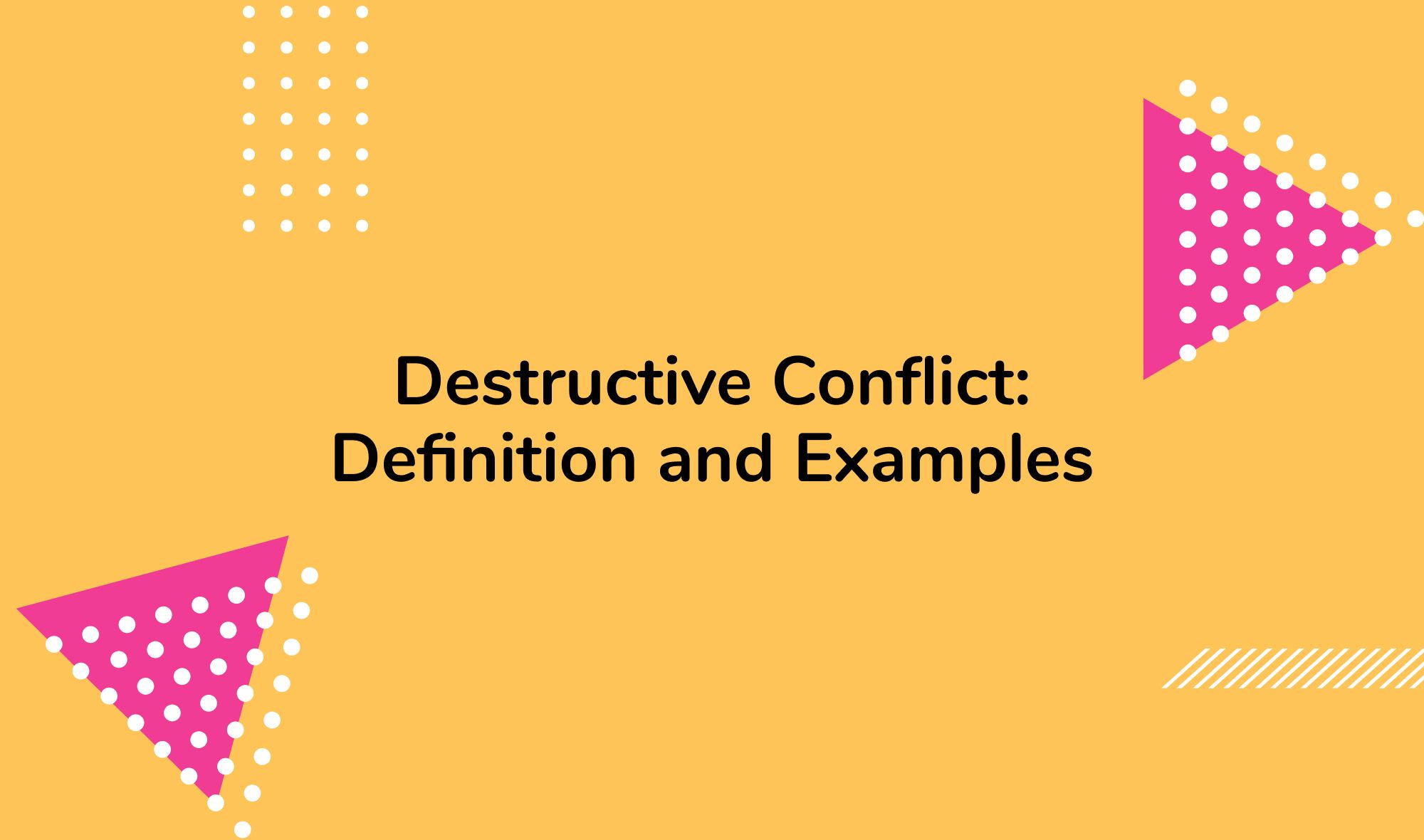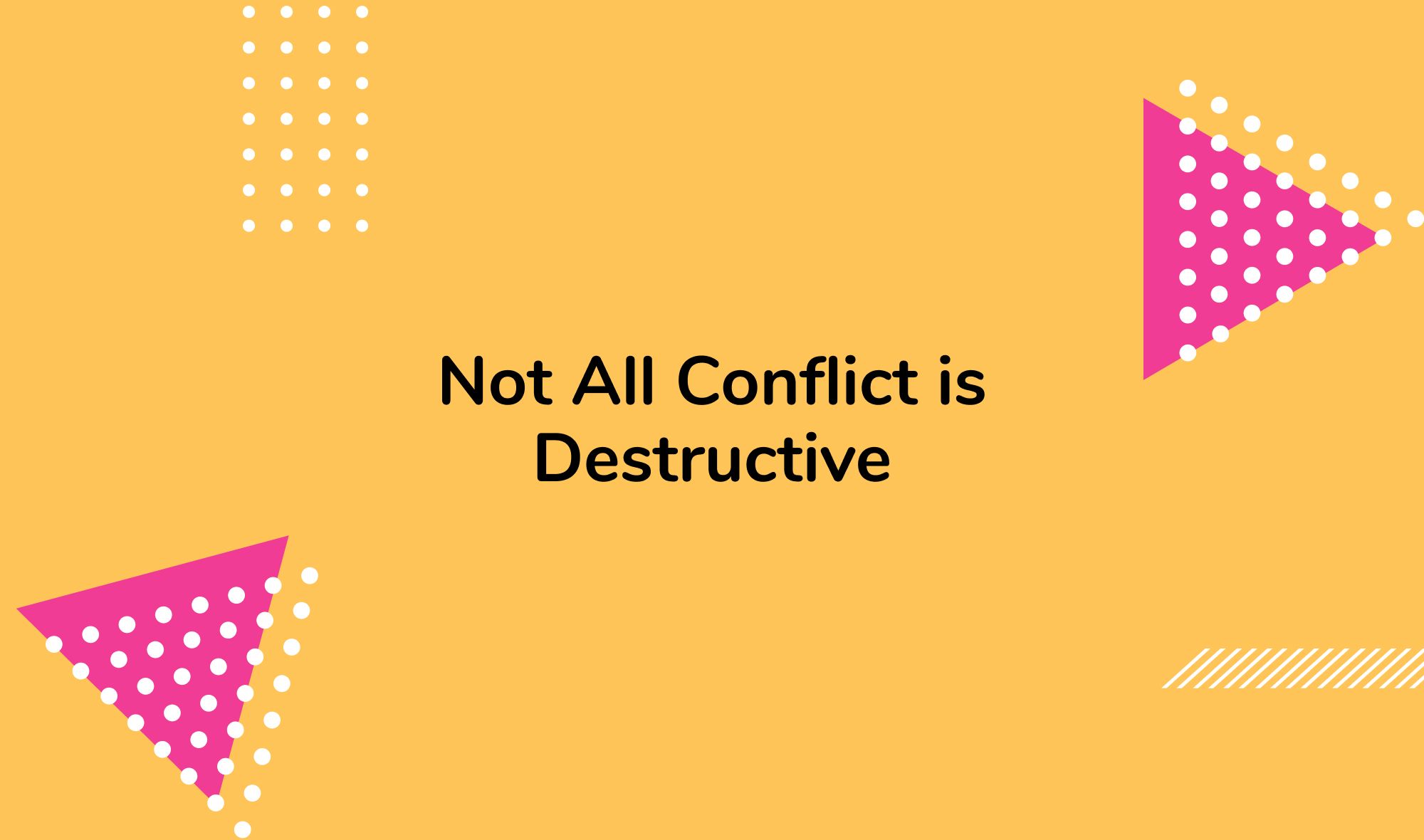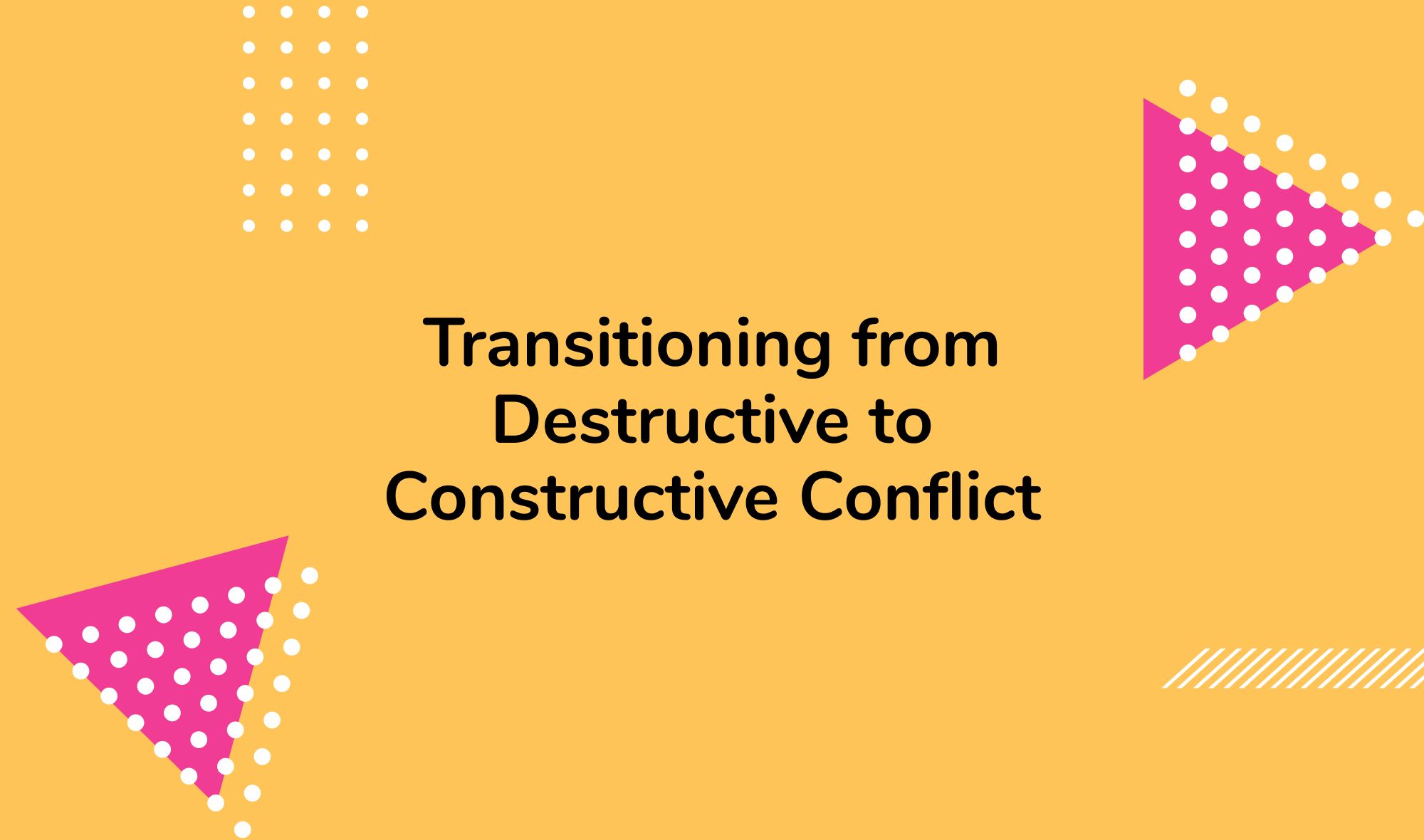Constructive Conflict: Navigating the Silver Lining in Disagreements
By Marco Franzoni • July 5, 2023
Key Takeaways
- Constructive conflict is beneficial, encouraging creativity, growth, and better decision-making.
- Destructive conflict hinders progress, but can be converted to constructive conflict through communication, empathy, and understanding.
- Conflict resolution skills are crucial in both personal and professional life.
- Viewing conflict as an opportunity for growth can lead to improved relationships and personal and professional development.

"Not all conflict is destructive." It's a bold statement that can often provoke a mix of agreement and doubt. But let's face it, disagreements and differences are a normal part of human interactions, especially within diverse teams in the workplace.
However, when conflict arises, it doesn't always lead to a negative outcome. Quite the opposite. If managed correctly, conflict can produce positive outcomes, pushing the status quo, fostering creativity, and leading to innovative solutions. This is where the concept of constructive conflict enters the conversation.
Understanding the difference between constructive and destructive conflict can completely alter how we perceive and manage disagreements. Constructive conflict, characterized by open communication, respect for differing views, and a focus on problem-solving, can improve the working relationship of team members and contribute to the overall success of an organization. On the other hand, destructive conflict can cause frustration, hinder productivity, and create a toxic environment.
In this post, we'll delve into the definitions of constructive and destructive conflict, provide examples, and guide you on how to encourage constructive conflict while mitigating destructive conflict in your team or organization. So, whether you're an employee seeking to improve your communication skills or a leader aiming to enhance team dynamics, there's something valuable for you to take away from this read.
Ready to explore this silver lining in disagreements? Let's dive in.
Join our Newsletter
Transform your career with our personal growth insights. Get one valuable tip right in your inbox every Saturday morning.
Constructive Conflict: Definition and Importance
Constructive conflict, as the term implies, refers to conflict that is both productive and beneficial to the parties involved. It arises when people disagree over ideas, decisions, or directions, yet maintain an atmosphere of respect and openness. The difference between constructive and destructive conflict lies primarily in how the disagreement is approached, managed, and resolved.
The main characteristics of constructive conflict include:
- Open communication: Parties involved feel comfortable expressing their thoughts and emotions without fear of reprisal.
- Respect for different opinions: Each person's viewpoint is valued, fostering an environment that encourages people to share their ideas.
- Focus on problem-solving: Rather than trying to 'win' the argument, the aim is to find a mutually beneficial solution.
Constructive conflict is of great importance in various areas of life:
- Personal: Constructive conflict encourages self-awareness and helps us understand others' perspectives. It promotes personal growth by challenging our assumptions and expanding our worldview.
- Professional: Constructive conflict can play a significant role in improving workplace dynamics. It stimulates innovation, encourages diverse thinking, and can lead to better decision-making.
- Social: Constructive conflict can strengthen relationships and improve community cohesiveness. When differences are addressed constructively, it builds understanding and promotes harmony.
Understanding how constructive conflict works and how to harness it can lead to positive outcomes. By focusing on the issue at hand, maintaining open communication, and respecting differing views, it's possible to turn a potentially disruptive situation into an opportunity for growth and development.
Destructive Conflict: Definition and Examples

Destructive conflict represents a type of conflict that hinders progress, damages relationships, and creates a negative environment. Unlike constructive conflict which can lead to growth and development, destructive conflict has the opposite effect: it halts creativity, fosters resentment, and can trigger negative outcomes.
Key indicators of destructive conflict include:
- Personal attacks: Rather than focusing on the problem at hand, conversations become personal, and the objective shifts from finding a solution to blaming or criticizing the other party.
- Defensiveness: Parties involved are more interested in defending their viewpoint than understanding the differing views of the other party.
- Negativity: The conflict fosters a negative atmosphere that impacts not just the parties involved but also other team members and the overall team dynamics.
An example of destructive conflict could be a disagreement in the workplace over resource allocation where one party refuses to listen to the other party's viewpoints, leading to an impasse and feelings of frustration. In extreme cases, destructive conflict can lead to hostility and even violence.
Destructive conflict can have a significant detrimental impact on an organization. It hinders growth and development by creating an environment where employees feel unheard and undervalued, leading to decreased morale and productivity.
In our blog post about addressing cultural conflict, we discussed how unchecked destructive conflict could cause irreparable damage to the working relationships in a culturally diverse team. Such conflict can stifle the creative synergy of different perspectives and deter the team from achieving its potential.
Not All Conflict is Destructive

Not all conflict leads to negative outcomes. It's essential to recognize the distinction between destructive conflict and constructive conflict. The main difference lies in the approach and attitude of the parties involved.
Constructive conflict, as we discussed earlier, can act as a catalyst for creativity, encourage people to consider different opinions, and foster personal growth and team development. On the other hand, destructive conflict promotes division, stagnation, and frustration, leading to negative outcomes.
When we say "not all conflict is destructive," we underscore the potential for conflict to become a tool for positive change if managed correctly. The same disagreement that could have spiralled into a destructive conflict could lead to a positive outcome if addressed with open communication, mutual respect, and a willingness to understand others' perspectives.
Constructive and destructive conflict differ primarily in their impact:
- Resolution and Growth: Constructive conflicts typically result in a resolution that benefits both parties. It can facilitate personal and professional growth as individuals develop better communication skills, become more self-aware, and learn to view issues from multiple perspectives. Destructive conflicts, however, typically don't result in a positive resolution, and growth is stunted.
- Response to Disagreement: Constructive conflicts view disagreement as an opportunity to innovate and improve. It encourages the sharing of differing views in a respectful, open manner. In contrast, destructive conflict often involves parties who perceive disagreement as a threat, leading to defensive behavior and closed communication.
- Effect on Relationships: Constructive conflict can strengthen relationships as parties learn to navigate differences and work together toward a solution. Destructive conflict damages relationships, leading to resentment, decreased cooperation, and potential disintegration of the working relationship.
Understanding the difference between constructive and destructive conflict is a crucial first step in managing and transforming conflict for the benefit of all parties involved and the broader team. In the next sections, we will explore how to promote constructive conflict and mitigate destructive conflict in the workplace.
Join our Newsletter
Transform your career with our personal growth insights. Get one valuable tip right in your inbox every Saturday morning.
Transitioning from Destructive to Constructive Conflict

So, how do we move from destructive conflict to constructive conflict? The answer lies in cultivating empathy, improving communication, and fostering understanding among team members.
Communication is a vital tool in transitioning from destructive to constructive conflict. Open and honest dialogue allows for the sharing of different opinions, acknowledging feelings, and discussing potential solutions. Encourage people to listen as much as they speak. Active listening shows respect for the other party, validates their feelings, and promotes a more open and cooperative atmosphere.
Empathy, the ability to understand and share the feelings of another person, plays a crucial role in conflict resolution. By developing empathy, parties involved in the conflict can gain insight into others' perspectives and foster an environment of mutual respect and understanding.
Understanding, in the context of conflict resolution, involves recognizing the causes and consequences of a conflict. This understanding enables the team to identify the root causes of the conflict, learn from them, and develop strategies to prevent similar issues in the future.
Shifting perspectives is another important element of conflict resolution. Often, parties involved in a conflict are entrenched in their positions and find it difficult to see the situation from the other's point of view. Encouraging a shift in perspective can help everyone involved to appreciate the other's position and work towards a resolution that benefits all parties.
Here are some strategies to promote a shift from destructive to constructive conflict:
- Develop and improve communication skills: Regularly hold team building exercises and brainstorming sessions that emphasize the importance of effective communication in conflict resolution.
- Cultivate empathy: Encourage team members to express their feelings and share their viewpoints, helping others to understand their perspectives.
- Understand the conflict: Identify the underlying issues causing the conflict. By understanding the root causes, teams can better address the problem and prevent it from reoccurring.
- Shift perspectives: Encourage team members to consider the viewpoints of others. This can be achieved through role-play exercises or through open, facilitated discussions where team members share their perspectives.
- Involve a neutral third party: Sometimes, the help of an unbiased third party, such as a manager, a HR department representative, or an external conflict resolution expert, can be beneficial in guiding the conversation towards a more constructive conflict.
Remember, the goal isn't to eliminate conflict but to create an environment where conflict can be resolved constructively. By encouraging constructive conflict, teams can leverage differing views to foster creativity, improve problem-solving, and build stronger, more resilient teams. The following sections will delve into more details on how we can encourage constructive conflict in the workplace.
How to Successfully Create Constructive Conflict
Creating constructive conflict may seem counter-intuitive. After all, isn't conflict something we usually try to avoid? However, when managed well, constructive conflict can be a powerful catalyst for innovation, creativity, and growth. Here's how you can successfully create constructive conflict:
- Encourage diversity of thought: Homogeneous groups tend to agree with each other, maintaining the status quo. Encourage people to express differing views and opinions to stimulate conversation and creativity.
- Create a safe environment: Constructive conflicts arise in an environment where team members feel safe to express their ideas without fear of retaliation or judgement. Develop an atmosphere of trust and mutual respect to encourage open communication.
- Set clear expectations and ground rules: Before engaging in potentially conflicting situations, establish some guidelines. Examples might include respecting others' ideas, listening before responding, or focusing on the issue, not the person.
- Promote open communication: Encourage people to voice their opinions, even if they disagree. Ensure communication is clear, direct, and respectful.
- Practice active listening: One of the most powerful communication skills is listening. This shows respect for the speaker, demonstrates that you value their opinion, and encourages them to share more.
- Teach and reinforce constructive responses to disagreement: It's important to respond to disagreement constructively. This might mean asking clarifying questions, seeking to understand the other's viewpoint, or proposing alternative solutions.
- Involve everyone: Constructive conflict is more likely when all team members are involved. This not only ensures diverse perspectives but also promotes shared ownership of solutions.
By following these steps, constructive conflict can lead to more creative solutions, better decision-making, and ultimately, a stronger, more resilient team. For more on this subject, the book "Everyone Can Win: Responding to Conflict Constructively" offers valuable insights and practical strategies for encouraging constructive conflict.
Conflict Resolution: Navigating Conflicts Constructively
Effectively managing conflict, whether it's constructive or destructive, requires robust conflict resolution skills. These skills not only help us navigate the choppy waters of disputes but also ensure we reach a resolution that benefits everyone involved.
Here are a few conflict resolution strategies to consider:
- Mediation: This involves a neutral third party - a mediator - facilitating a conversation between the conflicting parties to reach a mutually acceptable solution. The mediator does not impose a solution but helps the parties communicate, understand each other's perspectives, and develop their own resolution.
- Negotiation: Here, the parties involved communicate directly with each other, discussing their needs, desires, and the possible outcomes they would accept. Effective negotiation often involves compromise and aims to find a win-win solution.
- Arbitration: In this case, a neutral third party (the arbitrator) listens to each party's argument and then makes a binding decision. This method is more formal and is often used when other conflict resolution strategies have failed.
- Collaborative Problem Solving: This involves the parties involved working together to find a solution that meets everyone's needs. It requires open communication, understanding, and creativity.
- Active Listening: Active listening involves genuinely trying to understand the other person's point of view, demonstrating empathy, and making sure they feel heard and understood.
Conflict resolution skills are crucial in both our personal and professional lives. They enable us to handle disagreements constructively, maintain positive relationships, and work toward solutions that satisfy everyone involved. For more on effective conflict resolution, the Conflict Resolution Center provides an excellent resource, with various programs and workshops designed to enhance your conflict resolution capabilities.
Conclusion: The Silver Lining in Disagreements
In the journey of personal and professional growth, conflicts, disagreements, and differences are not roadblocks but rather opportunities. The key lies in our approach - viewing these challenges not as threats but as platforms for innovation, growth, and improvement.
Adopting a constructive approach to conflict, including internal conflict, can pave the way for better decision-making, enhanced creativity, and even strengthened relationships. After all, understanding stems from differing opinions and perspectives. As we have discussed, the choice between constructive conflict and destructive conflict can make all the difference in both the outcome and the impact on the parties involved.
By applying the strategies and tools we have discussed, you can encourage constructive conflict in your personal life, professional environment, and social interactions. Remember, it's about how you navigate the conflict and use it as an opportunity for learning, understanding, and growth.
Do not shy away from differences; embrace them. They provide an opportunity to explore fresh ideas, challenge the status quo, and instigate necessary changes. And when disagreements do arise, see them as an opportunity to grow and to foster stronger relationships rather than a disruption.
To continue developing your skills and knowledge in managing conflicts, consider exploring our other resources on self-awareness, dispute resolution techniques, and managing conflict at the workplace.
To learn more about building a better business and addressing negative workplace culture, read our blog post on identifying and correcting negative workplace culture.
Remember, conflict isn't necessarily negative. It's how you handle it that matters.
Read more about: Culture, Professional Development, Executive Coaching